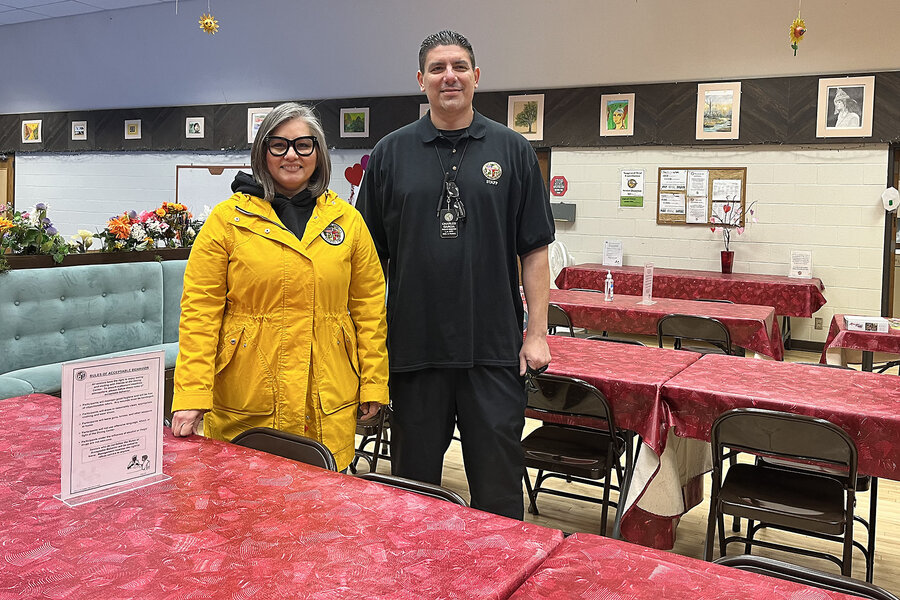Massive deluge tests California’s readiness and resolve
Loading...
| Los Angeles
Charles Garcia got the call Saturday night. Officials were expecting a mandatory evacuation of residents along La Tuna Canyon Road due to a slow-moving, massive rainstorm forecast to slam into Southern California the next day. Could he ready the senior center in Sunland, a neighborhood in northern Los Angeles, to receive local residents?
Upward of 14 million residents are under a high risk of excessive rain across Southern California on Monday, as a widespread storm moved in from the Pacific Ocean over the weekend. It has pummeled much of the state with gale-force winds and heavy rain, causing falling trees, flooding, and downed power lines. More than 500,000 people had experienced power outages as of Monday morning. Two people died in Northern California from trees that fell.
Why We Wrote This
Southern California faces increasingly supercharged weather – prodding the state to ramp up preparedness efforts such as for evacuations and rescues.
The storm is taking its time, and that’s part of the problem as rain totals pile up on top of ground already saturated by an earlier storm. In areas of Los Angeles, the storm is expected to have dropped close to half a year’s worth of rain by the time it winds down on Tuesday.
But as storms grow more intense, the state has also been investing increasingly in preparedness efforts – like Mr. Garcia’s – to keep people safe.
Charles Garcia got the call Saturday night. Officials were expecting a mandatory evacuation of residents along La Tuna Canyon Road due to a slow-moving, massive rain storm forecast to slam into Southern California the next day. Could he ready the senior center in Sunland, a neighborhood in northern Los Angeles, to receive local residents?
The mountainous area was in danger of landslides because a fire just two years ago had left steep slopes vulnerable. By 6:30 a.m. Sunday, Mr. Garcia was at the senior center, setting up tables with tablecloths for meals and snacks and marking off a section for 125 cots. He well remembers California’s exceptionally wet winter last year, and says the storms “are definitely more frequent.”
Welcome to California, famed for its Mediterranean climate but now trying to adapt to more intense weather, be it drought, fire, or rain. Already at the start of last week, outreach workers were fanning out across the Los Angeles basin to warn homeless people of the approaching megastorm, directing them to four local shelters. The governor mobilized thousands of state transportation workers, hundreds of first-aid responders, swift-water rescue teams, and provided for millions of sandbags across the state.
Why We Wrote This
Southern California faces increasingly supercharged weather – prodding the state to ramp up preparedness efforts such as for evacuations and rescues.
“California is ready with a record number of emergency assets on the ground to respond to the impacts of this storm,” said Gov. Gavin Newsom on Sunday, as he announced a state of emergency across eight counties in Southern California. In the past five years, California will have spent a total of $40.2 billion of its state budget to mitigate climate change and its impacts.
A storm’s widespread damage
Now comes the test of how the state’s rising efforts at preparedness are working – after more than 6 inches of precipitation in Los Angeles by Monday morning and significant rainfall elsewhere.
Upward of 14 million residents were under a high risk of excessive rain across Southern California, as a widespread storm moved in from the Pacific Ocean over the weekend. It has pummeled much of the state with gale-force winds and heavy rain, causing toppled trees, flooding, and downed power lines. More than 500,000 people had experienced power outages as of Monday morning. Two people died in Northern California from trees that fell.
The storm is taking its time, and that’s part of the problem as rain piles atop ground already saturated by an earlier storm. In areas of Los Angeles, the storm is expected to have dropped close to half a year’s worth of rain by the time it winds down on Tuesday.
Flows of mud and debris damaged homes in the Hollywood Hills area and forced residents to flee. The National Weather Service in Los Angeles described conditions there and in the surrounding Santa Monica Mountains as an “extremely dangerous situation” and warned of “life-threatening landslides and additional flash flooding.” In the Sierra Nevada mountains, some parts have measured more than 2 feet of snow this week.
“Weather whiplash,” or swings between drought and rain, is not unusual for California, according to scientists. This is an El Niño weather year, when trade winds in the Pacific weaken and push warm water toward the West Coast, producing wetter-than-usual winters and flooding. But as climate change warms the oceans, that adds to the fuel for more intense storms.
Residents brace for storm impact
Back at the Sunland senior center on Sunday, Los Angeles City Council member Monica Rodriguez dropped by to check in on things. She started her day at 3:30 a.m., coordinating with first responders, police, and others to receive evacuees – including animals. A nearby coffee shop was preparing hot drinks for the center, and LA Animal Services was set to deliver small cages for house pets.
Ms. Rodriguez had also been to the La Tuna Canyon area that morning to explain the weather conditions and build trust with the community about a likely evacuation. “This is an area that has historically experienced mass evacuations in the past, largely because of wildfire,” she says. But not everyone heeds the warnings. As of early afternoon on Monday, no one was at the senior center, though a handful of residents had reportedly gone to stay with family and friends. “There’s evacuation fatigue,” Ms. Rodriguez says.
It’s also an area with a lot of horses. By 11 a.m., a mandatory evacuation had been called, and horse trailers were pulling into the Hansen Dam Horse Park, just a few miles away from the senior center. When it comes to providing emergency shelter for large animals, this was not the first rodeo for Marnye Langer, general manager of the park. Because the site is also used for events and horse shows, it had just under 350 stalls ready and waiting.
This was a big help to Sheila McClure, who operates La Tuna Stables, which boards horses on La Tuna Canyon Road. She worked quickly to unload horses from a trailer and settle them into their stalls. “Better safe than sorry,” she said, as overhead clouds threatened. Last year, the fire department told her she was on the fringe of a mudslide area. But she couldn’t stop to talk. “I’ve got to go back and get more horses.”











